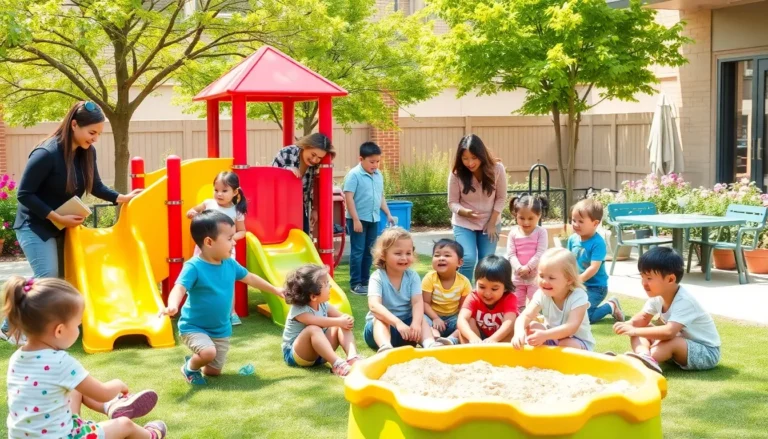In a world where parenting advice often feels like a game of dodgeball, positive parenting emerges as the ultimate power-up. It’s not just about avoiding the pitfalls of traditional discipline; it’s about creating a nurturing environment where kids thrive and parents don’t lose their minds. Imagine a household where laughter reigns, tantrums are managed with grace, and everyone gets a gold star for effort—even when the effort is just getting out of bed.
Positive parenting isn’t just a trend; it’s a game-changer. It emphasizes connection over correction, transforming everyday challenges into opportunities for growth. With the right approach, parents can foster resilience, confidence, and a sense of humor in their little ones. So, buckle up for a journey through the art of positive parenting, where the only thing more contagious than a child’s giggle is a parent’s newfound peace of mind.
Table of Contents
ToggleUnderstanding Positive Parenting
Positive parenting focuses on creating a supportive environment that fosters emotional growth. It emphasizes the strength of the parent-child bond, transforming challenges into valuable learning experiences.
Definition of Positive Parenting
Positive parenting is an approach centered on respect, understanding, and guidance. It encourages open communication and helps children build self-esteem. This method encompasses active listening and empathizing, leading to stronger connections. Parents become role models, showing emotional regulation and resilience. Creating a safe space allows children to express themselves freely. This definition serves as a foundation for nurturing healthy relationships.
Key Principles of Positive Parenting
Key principles drive positive parenting, including empathy, respect, and consistency. Empathy involves recognizing a child’s feelings and validating their experiences. Respect encompasses treating children as capable individuals deserving of consideration. Consistency allows children to feel secure, establishing predictable boundaries. Positive reinforcement highlights achievements, promoting desired behaviors. Encouragement builds confidence, offering children the motivation to try new things. By adhering to these principles, parents foster a nurturing atmosphere conducive to growth.
Benefits of Positive Parenting

Positive parenting offers myriad advantages that enhance children’s lives and strengthen family bonds. Emotional growth and behavioral improvements stand as two core benefits of this nurturing approach.
Emotional Development
Emotional development thrives in a positive parenting environment. Parents cultivate emotional intelligence through validation and empathy, allowing children to express feelings openly. Children recognize their emotions, leading to healthier coping mechanisms. Stronger self-esteem emerges as they feel understood and valued. Increased resilience also results from their experiences in navigating emotions. Open communication encourages them to share their thoughts, further fostering emotional connections with their parents. By prioritizing emotional well-being, families create a supportive atmosphere that nurtures positive relationships.
Behavioral Improvements
Behavioral improvements naturally follow positive parenting practices. Consistent guidance reinforces appropriate actions while establishing clear boundaries. Children learn about consequences in a constructive manner, which reduces the likelihood of negative behaviors. Positive reinforcement highlights achievements, encouraging more desirable actions. A sense of responsibility develops as they understand the impact of their choices. Engaging in problem-solving together builds cooperative behavior, transforming challenges into opportunities for growth. Over time, these improvements create a harmonious environment where children thrive and excel.
Techniques for Positive Parenting
Positive parenting techniques create an environment where children thrive. Effective communication and clear boundaries play a vital role in this nurturing approach.
Effective Communication
Open dialogue fosters trust between parents and children. Parents should encourage their kids to express feelings, actively listening to their concerns. Acknowledging emotions validates children’s experiences and promotes understanding. Parents can ask open-ended questions to invite discussions about daily activities or feelings. By modeling calm communication, parents teach their children essential skills for resolving conflicts non-confrontationally. Maintaining eye contact and using encouraging words can make children feel heard and valued. Frequent check-ins throughout the day enhance emotional connection. The focus remains on building a strong parent-child bond through ongoing conversations.
Setting Boundaries and Expectations
Establishing boundaries provides necessary structure in a child’s life. Clearly defined rules help children understand acceptable behaviors and consequences. Parents should communicate these expectations consistently, ensuring children comprehend their importance. Visual aids, such as charts or lists, reinforce daily routines and responsibilities. Age-appropriate rules encourage autonomy while promoting accountability. Parents can involve children in discussions about potential boundaries, fostering collaboration and cooperation. Consistent follow-through on established consequences teaches the significance of following rules. Encouraging self-discipline within these parameters nurtures responsibility and builds confidence in children.
Common Challenges in Positive Parenting
Positive parenting presents unique challenges that require awareness and strategic approaches. Parents often encounter frustrations that can arise during everyday interactions.
Dealing with Frustration
Frustration often surfaces when expectations clash with reality. Parents tend to feel overwhelmed by children’s unpredictable behaviors. Recognizing this challenge allows for better management of emotions. Taking deep breaths and maintaining calmness helps in addressing situations constructively. Prioritizing empathy is vital, as understanding a child’s perspective can defuse tension. Reflecting on one’s own feelings also aids in recognizing triggers. It’s necessary to channel frustration into teaching moments, transforming challenges into opportunities for growth.
Overcoming Resistance
Resistance can manifest in various forms, including defiance or refusal to comply with requests. Engaging in open communication often lessens pushback from children. Encouragement to express their thoughts fosters a sense of autonomy. Parents can offer choices, empowering children while establishing limits. Building trust leads to greater collaboration, making children more willing to cooperate. Demonstrating patience is crucial; success may take time. Consistently reinforcing positive behaviors by acknowledging and celebrating small victories inspires motivation for future compliance.
Embracing positive parenting transforms the family dynamic into one of mutual respect and understanding. By focusing on empathy and open communication parents not only nurture their children’s emotional growth but also strengthen their bond. This approach turns everyday challenges into valuable lessons fostering resilience and cooperation.
As parents apply these principles they create a supportive environment where children can thrive. The journey of positive parenting may have its challenges but the rewards of raising emotionally intelligent and well-adjusted children make it worthwhile. Ultimately it’s about building a foundation for a harmonious household filled with love and laughter.




